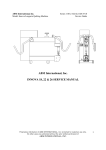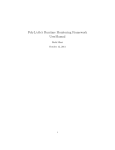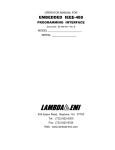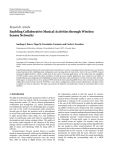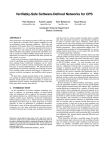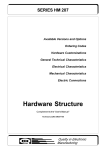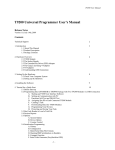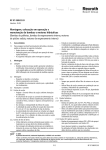Download StaRVOOrS User Manual
Transcript
StaRVOOrS User Manual
16 Abril, 2015
Jesús Mauricio Chimento
Contents
1 Introduction
2 The
1
StaRVOOrS Framework
3 Composing a ppDATE specification
3.1 ppDATE specification language . . . . .
3.2 Composing the script of a ppDATE file
3.2.1 Imports . . . . . . . . . . . . . .
3.2.2 Global . . . . . . . . . . . . . . .
3.2.3 CInvariants . . . . . . . . . . . .
3.2.4 Contracts . . . . . . . . . . . . .
3.2.5 Methods . . . . . . . . . . . . . .
1
.
.
.
.
.
.
.
.
.
.
.
.
.
.
.
.
.
.
.
.
.
.
.
.
.
.
.
.
.
.
.
.
.
.
.
.
.
.
.
.
.
.
2
2
4
4
5
5
6
6
4 Using the
tool
4.1 Working Example: Login Scenario . . . . . . . . . .
4.2 Running StaRVOOrS . . . . . . . . . . . . . . . .
4.3 StaRVOOrS ouput . . . . . . . . . . . . . . . . . .
4.4 StaRVOOrS execution insights . . . . . . . . . . .
4.5 Running the application with the generated monitor
.
.
.
.
.
.
.
.
.
.
.
.
.
.
.
.
.
.
.
.
.
.
.
.
.
6
7
7
7
8
9
StaRVOOrS
5 Example Files
.
.
.
.
.
.
.
.
.
.
.
.
.
.
.
.
.
.
.
.
.
.
.
.
.
.
.
.
.
.
.
.
.
.
.
.
.
.
.
.
.
.
9
Static
ppDATE
S
Prog. P
Par&al Specifica&on Evalua&on DATE
ppDATE
Specifica&on Transla&on S’
D
Monitor
Prog. P’
(partial)
Proofs
Monitor Generator Code Instrumenta&on Aspects
Deduc&ve Verifier Prog. P”
(weaved)
Weaving Code Figure 1: High-level description of the StaRVOOrS framework workflow
1
Introduction
Runtime verification and static verification are widely used verification
techniques. Runtime verification is concerned with the monitoring of software,
providing guarantees that observed executions of a program comply with
specified properties. This approach can be used on systems of a complexity
that is difficult to address by static verification such as systems with numerous
interacting sub-units, heavy usage of mainstream libraries, and real world
deployments. On the other hand, with runtime verification it is not possible
to extrapolate about all possible execution paths. Furthermore, monitoring
incurs runtime overheads which may be prohibitive in certain systems.
StaRVOOrS addresses these issues by combining runtime verification
with static verification. This tool starts by statically verifying the system
against a specification written in ppDATE [1], identifying parts which can
either be verified automatically or partially resolved, thus leaving a simpler
specification to check at runtime, in turn reducing the overheads induced by
monitoring.
2
The
StaRVOOrS Framework
The StaRVOOrS framework (Static and Runtime Verification of ObjectOriented Software) combines the use of the deductive source code verifier
KeY [2] with that of the runtime monitoring tool Larva [3]. KeY is a deductive verification system for data-centric functional correctness properties
of Java source code, which generates, from JML and Java, proof obligations in dynamic logic (a modal logic for reasoning about programs) and
attempts to prove them. Larva (Logical Automata for Runtime Verification
and Analysis) [3] is an automata-based Runtime Verification tool for Java
programs which automatically generates a runtime monitor from a property
using an automaton-based specification notation DATE. Larva transforms
the specification into monitoring code together with AspectJ code to link
the system with the monitors.
1
Fig. 1 gives an abstract view of the framework workflow. Given a Java
program P and a specification S of the properties to be verified, given in
the language ppDATE [1], these are transformed into suitable input for
the Deductive Verifier module which, in principle, might statically fully
verify the properties related to pre/post-conditions. What is not proved
statically will then be left to be checked at runtime. Here, not only the
completed but also the partial proofs are used to generate path conditions
for not statically verified executions. The Partial Specification Evaluator
module then rewrites the original specification S into S’, refining the original
pre-conditions with the aforementioned path conditions. Note that S’ is no
longer a full specification of the desired behaviour. Instead, it only specifies
executions that are not covered by the static verification.
In a next step, the resulting ppDATE specification S’ is, via Specification
Translation, turned into a specification in DATE format (D), suitable for the
runtime verifier. As DATE has no native support for pre/post-conditions,
these are simulated by pure DATE concepts. This also requires changes
to the code base (done by the Code Instrumentation module), like adding
counters to distinguish different executions of the same code unit, or adding
methods which operationalise pre/post-condition evaluation. The instrumented program P’ and the DATE specification D are given to the Monitor
Generator, which uses aspect-oriented programming techniques to capture
relevant system events. Later on, the generated aspects are weaved (Weaving
Code) into P’. The final step in the workflow is the actual runtime verification,
which executes the weaved program P” — running the original program in
parallel with a monitor of the simplified property. In case of a runtime error,
a trace is produced to be analysed.
3
Composing a ppDATE specification
In this section we will first introduce the ppDATE specification language and
then we will go through a ppDATE specification file explaining the meaning
of each one of its sections together with examples of syntax details.
3.1
ppDATE specification language
Formalisms for specifying software generally fall into two categories — either
data-oriented approaches (like first-order logic) are strong in describing datarelated properties but only at specific points of the execution, while controloriented property languages (such as LTL) specialise more in specifying legal
control paths. StaRVOOrS uses the automata-based specification language
ppDATEs as its property input language, which enables the combination
of data- and control-based properties in a single formalism [1]. At its core,
ppDATEs are a composition of the control-flow language DATE and more
2
q : {true} fileTransfer(f) {bytes == old(bytes)}
start
logout↓ | 7→
q0 :
login↑ | sessionIsOpen() 7→ c = 0
{true} fileTransfer(f) {bytes == old(bytes) + size(f)}
{write ∈ rights(f)} rename(f,n) {name(f) == n}
transferFile↓ | c ≤ 10 7→ c ++
transferFile↓ | c > 10 7→
bad
Figure 2: A ppDATE limiting file transfers
data-oriented specifications in the form of Hoare triples with pre-/postconditions, hence its name.
A ppDATE property is based on an alphabet of events which can be
detected when the system performs them. The events are typically entry and
exit points of methods and (named) blocks of code, and exception raising.
We write f↓ and f↑ respectively to denote the moment of entering and exiting
function or code block with name f. These detectable events, essentially
points of interest along the control paths followed by the system, are used to
drive the control-flow side of the specification.
Consider the ppDATE shown in Fig. 2. If we ignore the information given
in the states, the property is depicted as an automaton, more specifically in
the form of a DATE, in which transitions are tagged with triples: e | c 7→ a
— indicating that (i) they are triggered when event e occurs and condition
c holds; (ii) and apart from changing the state of the property, action a is
executed. For instance, the reflexive transition on the middle state is tagged:
transferFile↓ | c ≤ 10 7→ c ++, indicating that if the automaton is in the
middle state when the system enters the function named transferFile and
counter variable c does not exceed 10, then the counter is incremented by 1.
Some states are also identified as bad states, denoted using a double-outline
in the figure (see the bottom state), and used to indicate that if and when
reached, the system has violated the property in question. The property
represented in Fig. 2 can thus be understood to ensure that no more than 10
file transfers take place in a single login session.
Ignoring, for the moment, the information stored in the states and blockrelated events, this formalism is identical to DATEs. Both formalisms support
other features, including: (i) timers which may be used in the transition
conditions or as events to trigger transitions; (ii) communication between
automata using standard CCS-like channels with x! acting as a broadcast on
channel x and which can be read by another automaton matching on event
x?; and (iii) replication of automata through which every time a particular
event distinct from earlier ones (e.g. using a method’s parameters or the
target object) is received a new automaton is created (e.g. used to replicate a
3
property for each instance of a class). To illustrate the use of the last feature,
we note that in the case of a multi-user system, the property depicted in
Fig. 2 does not work as expected, since logins and logouts of different users
would interact with the property in undesirable ways. To resolve this issue,
we would enclose the property within a replication clause to ensure that an
instance of the property is replicated for each different user. By specifying
which instance of the property is used when an event is identified (e.g. one
can identify the user related to a login by identifying the target of the method
call), the automata are created by need and effectively execute in parallel.
The data-oriented features of the specification appear in ppDATEs in the
states. A state may have a number of Hoare triples assigned to it. Intuitively,
if Hoare triple {π} f {π 0 } appears in state q, the property ensures that: if the
system enters code block f while the monitor lies in state q, and precondition
π holds, then upon reaching the corresponding exit from f, postcondition π 0
should hold. Pre-/post-conditions in Hoare triples are expressed using JML
boolean expression syntax [4], which is designed to be easily usable by Java
programmers.
For instance, the Hoare triple appearing in the top state of the property
given in Fig. 2, ensures that any attempted file transfer when in the top state
(when logged out), should not change the byte-transfer count. Similarly,
while logged in (in the middle state of the property) (i) the number of bytes
transferred increases when a file transfer is done while logged in; and (ii)
renaming a file does indeed change the filename as expected if the user has
the sufficient rights.
To ensure efficient execution of monitors, ppDATEs are assumed to be
deterministic by giving an ordering in which transitions are executed. A
complete formalisation of ppDATEs can be found in [1].
3.2
Composing the script of a ppDATE file
A ppDATE specification is described on a file with extention .ppd. This
file consists in 5 sections (ordered as they are listed): Imports, Global,
CInvariants, Contracts and Methods.
3.2.1
Imports
Lists any packages (or files) which will be used in any of the other sections.
At least there should be an import of a package of the system to be monitored.
Each file name should be preceded by the word import.
The syntax for this section is as follows:
IMPORTS { import main.HashTable; }
4
3.2.2
Global
Describes the automaton (i.e. events, automata variables, transitions, states,
etc). This section is an extension of the Global section of Larva. In the
user manual of Larva, which can be accessed in www.cs.um.edu.mt/svrg/
Tools/LARVA/LARVA-manual.pdf, you can find a detail explanation for this
section. The only differences with ppDATE Global section is that in ppDATE
the definition of the states include a list of contracts to verify in each state.
This list appears right next to the name of the state. Furthermore, for the
time being, we do not support the use of Initial Code on the states definition.
The syntax for this section is as follows:
GLOBAL {
EVENTS {
add_entry(Object u,int key)={HashTable hasht.add(u, key)}
add_exit(Object u,int key)={HashTable hasht.add(u, key)uponReturning()}
}
PROPERTY add {
STATES
{
NORMAL { q2 ; }
STARTING { q (add_ok, add_full,hashfun_ok) ; }
}
TRANSITIONS {
q -> q2 [add_entry\hasht.contains(u, key) < 0\]
}
}
}
3.2.3
CInvariants
Class invariants are described in this section by class name {invariant}.
The syntax for this section is as follows:
CINVARIANTS {
HashTable {h.length == capacity}
HashTable {capacity >= 1}
}
It is not mandatory to include this section in the script, i.e. no class
invariants are needed for the static verification of the Hoare triples.
5
3.2.4
Contracts
Lists named Hoare triples. Each Hoare triple is described in a subsection
CONTRACT, whose header is follow by the name assigned to the contract.
On it, PRE describes the precondition of the Hoare triple, POST describes
the postcondition of the Hoare triple, METHOD describes which is the
moethod associated to the Hoare triple and ASSIGNABLE list the variables
that might be modified when the method associated to the Hoare triple is
executed. Both precondition and postcondition predicates follow JML-like
syntax and pragmatics.
The syntax for this section is as follows:
CONTRACTS {
CONTRACT add_ok {
PRE {size < capacity && key > 0}
METHOD {HashTable.add}
POST {(\exists int i; i>= 0 && i < capacity; h[i] == u)}
ASSIGNABLE {size, h[*]}
}
}
It is not mandatory to include this section in the script, i.e. it is not
desire to perform static verification.
3.2.5
Methods
Definition of methods to avoid having a lot of code on the transitions of
the automaton. Access modifiers (i.e. public, protected, private) are not
necessary when declaring these methods. If a method is declared as static
method, then monitor variables will not be accessible within that particular
method.
The syntax for this section is as follows:
METHODS {
int foo() {return 0;}
boolean goo(int v) {return true;}
}
4
Using the
StaRVOOrS tool
In this section we will show how to use StaRVOOrS by applying the tool
to a working example.
6
4.1
Working Example: Login Scenario
We consider a scenario where users attempt to log in into a system. On
this system, the set of logged users is implemented as a HashTable object,
whose class represents an open addressing hash table with linear probing as
collision resolution. The method add, which is used to add objects into the
hash table, first tries to put the corresponding object at the position of the
computed hash code. However, if that index is occupied then add searches
upwards (modulo the array length) for the nearest following index which is
free.
Within the hash table object, users are stored into a fixed array h,
meaning that the set has a capacity limited by the length of h. In order to
have an easy way of checking whether or not the capacity of h is reached, a
field size keeps track of the number of stored objects and a field capacity
represent the total amount of objects that can be added into the hash table.
The ppDATE specification, which will only specify a small part of the
system’s behaviour, will be focused on the method add. Whenever this
method is executed, on one transition of the automaton it will be verified
that the user to be added is not already logged in the system. Regarding
the pre/post-condition of the method add, it will be analysed two contracts:
add ok specifies that, if there is room for an object u in the hash table, then
after adding that object into the hash table it is found in one of the entries
of the array h ; add full specifies that, if there is no room for an object in the
hash table, then the hash table should not be modified when an attempt to
add a new user is performed. Besides, it is necessary to include a Hoare triple
related to the hash function: hashfun ok specifies that the hash function
should receive a positive value.
Note that both the HashTable class file and the ppDATE specification
are provided in Sec.5.
4.2
Running
StaRVOOrS
In order to run StaRVOOrS, the tool should be provided with 3 arguments:
(i) the Java files to be verified (the path to the main folder), (ii) a description
of the ppDATE as a script (a file with extension .ppd), and (iii) the path of
the output folder.
e.g. StaRVOOrS Example/Login Example/prop add.ppd Example
4.3
StaRVOOrS ouput
The output produced by StaRVOOrS consists on: the monitor files generated by Larva (folder aspects and folder larva), the files generated by
StaRVOOrS to runtime verify partially proven contracts (folder ppArtifacts), an instrumented version of the source code (folder Login), the xml
7
file used by StaRVOOrS to optimized the ppDATE specification (out.xml ),
a report explaning the content of the .xml file (report.txt) and the DATE
specification obtained as a result of translating the (optimized) ppDATE.
4.4
StaRVOOrS execution insights
StaRVOOrS is a fully automated tool. However, in order to have a better
understanding on what is going during its execution, below we will explain
it in three stages. Note that during each one of this stages StaRVOOrS
will produced some text output on the terminal which inform the user on
which stage the tool is working at.
The first stage corresponds to the static verification of the Hoare triples
using KeY. During this stage, first the KeY (taclet) options are set. This
options are parameters that tell KeY how it should proceed during the
verification process. For the time being, we are just using the standard
options. Then, KeY is ran.
While KeY analyses all the contracts (i.e. the Hoare triples), every time
KeY is done with one of them some information related to this analysis
is given as output in the terminal. All the information given as output
in the terminal is sum up in the generated file out.xml. This file is not
intended for the user, it is used by StaRVOOrS to optimized the ppDATE
specification. However, in order to provide the user with some understandable
feedback about what happened during the static verification of the contracts,
StaRVOOrS generates a file report.txt which briefly explains the content of
the .xml file.
The second stage correspond to the previously mentioned optimization.
On this stage, all the contracts which were proven are removed from the ppDATE specification and those which were only partially proven are modified
to include the conditions which lead to unclosed path on a proof.
When analysing the ppDATE specification of our working example, KeY
proves the contracts add full and hashfun ok, but it only partially proves
the contract add ok. As it can be read on the report, this contract will be
strengthen by adding to its precondition the predicate !(h[hash function(key)]==
null)
Whenever it is necessary to runtime verify partially proven contracts,
StaRVOOrS instruments the source code by adding a new parameter to
the method(s) associated to the contract(s). This new parameter is used to
distinguish different method calls. This change is introduced in the ppDATE
specification too. Besides, StaRVOOrS generates two files (both within a
folder name partialInfo): Contracts.java and Id.java. The former contains
methods which are generated from the pre-postconditions of the contracts,
which will be use by the monitor when verifying the respective contract. The
latter will be used to deal with new parameter added to the methods.
The third stage corresponds to the generation of the monitor files. In
8
order to do so, the ppDATE specification is translated by StaRVOOrS
to a DATE specification. Then, it is used Larva to generate the monitor
files from the previous DATE. Once the execution of Larva is completed,
StaRVOOrS execution is completed too.
4.5
Running the application with the generated monitor
Once StaRVOOrS finishes its execution, in order to run the application
together with the generated monitor the instrumented files have to replace
they old version (i.e. none instrumented) in the source code, the folders
aspects, larva and ppArtifacts have to be copied in the main folder where
the source code is placed and finally all these files must be compiled using
an aspectJ compiler (e.g. ajc).
5
Example Files
• ppDATE script (prop add ):
IMPORTS { import main.HashTable; }
GLOBAL {
EVENTS {
add_entry(Object u,int key)={HashTable hasht.add(u, key)}
add_exit(Object u,int key)={HashTable hasht.add(u, key)uponReturning()}
hfun_entry(int val)={HashTable hasht.hash_function(val)}
hfun_exit(int val,int ret)={HashTable hasht.hash_function(val)uponReturning(ret)}
}
PROPERTY add {
STATES
{
NORMAL { q2 ; }
STARTING { q (add_ok, add_full,hashfun_ok) ; }
}
TRANSITIONS {
q -> q2 [add_entry\hasht.contains(u, key) < 0\]
}}
}
CINVARIANTS {
HashTable {\typeof(h) == \type(Object[])}
HashTable {h.length == capacity}
HashTable {h != null}
HashTable {size >= 0 && size <= capacity}
HashTable {capacity >= 1}
}
CONTRACTS {
9
CONTRACT add_ok {
PRE {size < capacity && key > 0}
METHOD {HashTable.add}
POST {(\exists int i; i>= 0 && i < capacity; h[i] == u)}
ASSIGNABLE {size, h[*]}
}
CONTRACT add_full {
PRE {size >= capacity}
METHOD {HashTable.add}
POST {(\forall int j; j >= 0 && j < capacity; h[j] == \old(h)[j])}
ASSIGNABLE {\nothing}
}
CONTRACT hashfun_ok {
PRE {val > 0}
METHOD {HashTable.hash_function}
POST {\result >= 0 && \result < capacity}
ASSIGNABLE {\nothing}
}
}
• HashTable.java file:
public class HashTable {
// Open addressing Hashtable with linear probing as collision resolution.
public Object[] h;
public int size;
public int capacity;
HashTable (int capacity) {
h = new Object[capacity];
this.capacity = capacity;
size = 0;
}
public int hash_function (int val) {
return (val % capacity);
}
// Add an element to the hashtable.
public void add (Object u, int key) {
if (size < capacity) {
int i = hash_function(key);
if (h[i] == null) {
10
h[i] = u;
size++;
return;
}
else {
int j = 0;
while (h[i] != null && j < capacity)
{
if (i == capacity-1) i = 0;
else {i++;}
j++;
}
h[i] = u;
size++;
return;
}
} else {
return;
}
}
// Removes an entry from the hashtable.
public void delete (Object u, int key) {
int i = hash_function(key);
int j = 0;
while (!u.equals(h[i]) && (j < capacity))
{
if (i == capacity-1) i = 0;
else {i++;}
j++;
}
if (u.equals(h[i])){
size = size - 1;
h[i] = null;
}
}
// check if an intry is in hashtable.
//
If it is, then returns the position in the hashtable where it is.
//
If it isn’t, returns -1.
public int contains (Object u, int key) {
int i = hash_function(key);
11
int j = 0;
if (u == null) return -1;
while (!u.equals(h[i]) && (j < capacity))
{
if (i == capacity-1) i = 0;
else {i++;}
j++;
}
if (u.equals(h[i]))
return i;
else {return -1;}
}
// access to the entry of hashtable in the position idx.
public Object foo (int idx) {
return h[idx];
}
}
References
[1] W. Ahrendt, J. M. Chimento, G. J. Pace, and G. Schneider. A specification language for static and runtime verification of data and control
properties. In FM’15, volume 9109 of LNCS, pages 108–125. SpringerVerlag, 2015.
[2] B. Beckert, R. Hähnle, and P. Schmitt, editors. Verification of ObjectOriented Software: The KeY Approach, volume 4334 of LNCS. SpringerVerlag, 2007.
[3] C. Colombo, G. J. Pace, and G. Schneider. LARVA - A Tool for Runtime
Monitoring of Java Programs. In SEFM’09, pages 33–37. IEEE Computer
Society, 2009.
[4] G. T. Leavens, E. Poll, C. Clifton, Y. Cheon, C. Ruby, D. Cok, P. Müller,
J. Kiniry, and P. Chalin. JML Reference Manual. Draft 1.200, 2007.
12














